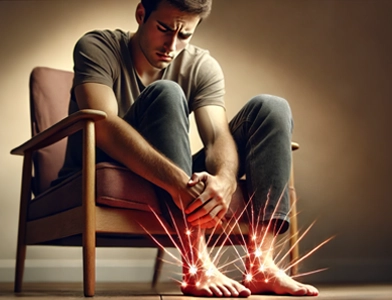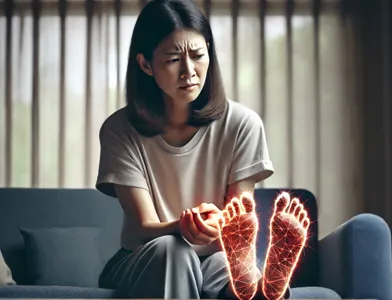Pins and Needles in the Extremities: Causes, Diagnosis, and Treatment
Pins and needles in the extremities, also known as paresthesia, are sensations of tingling or prickling. They are commonly felt in the arms, legs, hands, or feet and are often caused by pressure on nerves. These sensations can disappear quickly when the pressure is relieved. However, persistent or frequent episodes may signal an underlying health issue that needs medical attention.

What are Pins and Needles?
Pins and needles refer to tingling or prickling sensations commonly experienced in different body parts. The sensation of pins and needles can be unsettling, leading individuals to seek an understanding of the cause and potential remedies.
Definition of Pins and Needles
Pins and needles, medically known as paresthesia, is a sensory disturbance characterized by a tingling or prickling feeling on the skin. It is usually temporary and often occurs in the arms, legs, hands, or feet.
Common Symptoms
- Tingling sensation
- Prickling feeling
- Numbness in the affected area
Seeking Relief
- Changing position
- Removing pressure
Common Causes of Pins and Needles
Understanding what causes pins and needles in the extremities is essential for proper management and treatment. Various factors can contribute to this sensation, ranging from pressure on nerves to underlying medical conditions. Let’s explore some common causes:
Pressure on Nerves
- Poor Blood Supply: Inadequate blood flow to a specific area can lead to nerve compression and trigger pins and needles.
Neuropathy
- Peripheral Neuropathy: Damage to peripheral nerves from various factors like diabetes, infections, or trauma can result in nerve dysfunction and the sensation of pins and needles.
Diabetes
- Diabetes is a common cause of nerve damage, particularly in the peripheral nerves, leading to paresthesia in the extremities.
Carpal Tunnel Syndrome
- Carpal tunnel syndrome involves compression of the median nerve in the wrist, often causing pins and needles in the hand and fingers.
Vitamin Deficiencies
- Vitamin B12 Deficiency: Inadequate levels of vitamin B12 can affect nerve function, resulting in paresthesia.
Medical Conditions Linked to Pins and Needles

Medical conditions can play a significant role in the occurrence of pins and needles sensation in the extremities. Various disorders affecting the nervous system and other parts of the body can lead to these uncomfortable symptoms. Below are some conditions commonly linked to experiencing pins and needles:
Multiple Sclerosis
Multiple Sclerosis is a neurological condition that can cause damage to the protective covering of nerve fibers, leading to disruptions in communication between the brain and the body. This disruption can result in symptoms such as pins and needles, weakness, and numbness in the extremities.
Guillain-Barre Syndrome
Guillain-Barre Syndrome is a rare autoimmune disorder that affects the peripheral nervous system. It can lead to nerve inflammation and damage, causing symptoms like tingling, numbness, and muscle weakness, including pins and needles in the extremities.
Spinal Cord Injuries
Spinal cord injuries can result from trauma or conditions that damage the spinal cord, impacting the transmission of nerve signals. Depending on the location and severity of the injury, individuals may experience sensations like pins and needles, loss of sensation, or paralysis in the affected areas.
Central Nervous System Disorders
- Central nervous system disorders, such as Parkinson’s disease or stroke, can affect the brain and spinal cord, leading to a range of neurological symptoms.
- These conditions may disrupt nerve function and communication, resulting in sensations like pins and needles, muscle weakness, and coordination problems in the extremities.
Preventive Measures
When dealing with pins and needles in the extremities, taking preventive measures is crucial to manage symptoms and prevent future occurrences. Here are some important practices to consider:
Good Posture Practices
- Maintain a neutral spine position while sitting or standing.
- Use ergonomic furniture to support proper alignment.
- Take breaks to stretch and avoid prolonged periods of immobility.
Regular Exercise
- Engage in physical activities that promote circulation and nerve health.
- Incorporate strength training and flexibility exercises into your routine.
- Consult a fitness professional for personalized exercise recommendations.
Frequently Asked Questions (FAQs)
What causes pins and needles in the extremities?
Pins and needles in the extremities are often caused by peripheral neuropathy, which can result from conditions such as diabetes, nerve compression, autoimmune diseases, infections, and certain medications.
How is peripheral neuropathy diagnosed?
Peripheral neuropathy is diagnosed through a combination of medical history, physical examination, and diagnostic tests such as nerve conduction studies, electromyography (EMG), and blood tests to identify underlying conditions.
Can lifestyle changes help with pins and needles in the extremities?
Yes, lifestyle changes such as maintaining a balanced diet, regular exercise, managing blood sugar levels (for diabetics), and avoiding alcohol can help manage and reduce the symptoms of peripheral neuropathy.
Is pins and needles in the extremities a serious condition?
While pins and needles can be a benign and temporary sensation, persistent or severe symptoms may indicate a more serious underlying condition, such as peripheral neuropathy, and should be evaluated by a healthcare professional.
Can peripheral neuropathy be cured?
Peripheral neuropathy can often be managed effectively, but it may not be completely curable, especially if caused by chronic conditions like diabetes. The goal of treatment is to manage symptoms and improve quality of life.
How do I prepare for a consultation about my pins and needles symptoms?
To prepare for your consultation, keep a detailed record of your symptoms, including their frequency, duration, and any factors that seem to aggravate or relieve them. Bring your medical history, a list of medications, and any previous test results to help your healthcare provider make an accurate diagnosis.